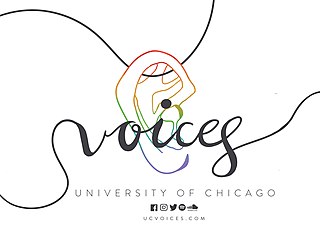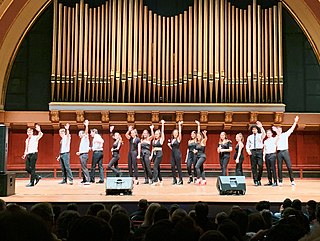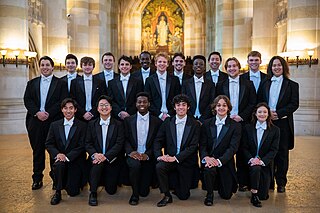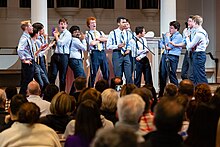
Music performed a cappella, less commonly spelled a capella in English, is music performed by a singer or a singing group without instrumental accompaniment. The term a cappella was originally intended to differentiate between Renaissance polyphony and Baroque concertato musical styles. In the 19th century, a renewed interest in Renaissance polyphony, coupled with an ignorance of the fact that vocal parts were often doubled by instrumentalists, led to the term coming to mean unaccompanied vocal music. The term is also used, rarely, as a synonym for alla breve.

Deke Sharon is an American singer, arranger, composer, director, producer, author, coach, pioneer, and teacher of a cappella music, and is one of the leaders and promoters of the contemporary a cappella community. He has been referred to as "the father of contemporary a cappella" and "the godfather of a cappella".
The International Championship of Collegiate A Cappella (ICCA), originally the National Championship of Collegiate A Cappella, is an international competition run by Varsity Vocals, that attracts hundreds of college a cappella groups each year.

Doox of Yale are an all-gender undergraduate a cappella group at Yale University. The group was founded by first-year students in 1952, and in 2017, was the first TTBB a cappella group in the 21st century at Yale to become all-gender.

BYU Vocal Point, or simply Vocal Point, is a seven to nine-member, male a cappella group at Brigham Young University (BYU). Founded by two students, Bob Ahlander & Dave Boyce, in 1991, Vocal Point is under the direction of former member Carson Trautman.

The Stanford Mendicants are an all-male a cappella group at Stanford University. The group is Stanford University's first a cappella group. Since its founding in 1963, the group's size has varied from 6 to 19 members. Although they are strictly an a cappella group today, they have performed with instruments in previous generations. The group prides itself on singing a wide range of songs, from gospel to barbershop to pop tunes and original compositions. The Mendicants are known around Stanford's campus for their red blazers and romantic serenades.

Voices in Your Head is a student-run a cappella group from the University of Chicago who aim to "push the bounds of contemporary a cappella." Founded in 1998, the group has consisted of both undergraduate and graduate students whose studies range from Economics to Music to MD/PhD programs. Its unique repertoire includes original pieces, as well as an eclectic mix of pop, R&B, rock, and alternative music. Voices competes regularly in the International Championship of Collegiate A Cappella (ICCA) and releases studio recordings of their arrangements.

The Stanford Harmonics are a co-ed a cappella group from Stanford University. Known for their alternative rock repertoire and award-winning recordings, the Harmonics have garnered international recognition for their performances and have been featured on BOCA, Sing, and Voices Only a cappella compilations. The Harmonics are one of the few collegiate a cappella groups that own their own wireless microphone equipment and have developed a live performance style that includes the use of electronic distortion and sound effects.
The Accidentals are an all-male collegiate a cappella group. Formed in 1974, the Accidentals are the oldest a cappella group at the University of Georgia. The Accidentals are typically anywhere from 12 to 17 members and hold auditions every fall and occasionally at the end of the spring

The Academical Village People (AVP) is an a cappella group at the University of Virginia founded in 1993 by a group of people who vowed to "never take themselves too seriously." They set themselves apart from other groups by being able to keep professional while maintaining their lax attitude, wild antics while performing, and their less traditional uniform of a garage mechanic style shirt. The name "Academical Village People" comes from Thomas Jefferson's Academical Village at the university in Charlottesville, Virginia. As of 2017, AVP, as it is often called for short, has released thirteen studio albums, including a greatest hits album, DECADEmical: Best of 1993-2003, of its first ten years in existence. The group has recorded many notable performances such as opening for Dana Carvey and Girl Talk, performing for Reba McEntire at the White House, concerts at the Kennedy Center, and performances in such countries as England, Spain, and Scotland.

The Compulsive Lyres is an a cappella group at the University of Michigan. The group includes both music and non-music majors and sings various arrangements of pop, rock, and R&B songs.

The Yale Alley Cats is an undergraduate a cappella singing group at Yale University, the college's third-oldest.

BYU Noteworthy is a seven to nine-member, female Brigham Young University (BYU) a cappella group, based in Provo, Utah, United States. They won 1st place at the International Championship of Collegiate A Cappella (ICCA) in 2007 and appeared on the first season of NBC's a cappella competition reality show The Sing-Off in 2009. Esther Yoder formed the group in 2003, aided by members of BYU's Vocal Point. Noteworthy began operating under the direction of the Performing Arts Management (PAM) at BYU in 2014. One of their most popular music videos is a cover of Amazing Grace, which won the Contemporary A Cappella Society (CARA) award for Best Religious Video and has garnered millions of views on YouTube since its release. Noteworthy has released six albums since its formation in 2003. In 2018, Noteworthy performed "Come Thou Fount of Every Blessing" for a Mormon Message for the Church of Jesus Christ of Latter-day Saints.

The House Jacks is a professional a cappella quintet from San Francisco, founded in 1991 by Deke Sharon.
Stanford Raagapella is Stanford University's South Asian focus a cappella group. The group was founded as an all-male group in 2002 and transitioned to an all-gender group in 2017. Stanford Raagapella has released three albums to date, Raags to Riches, Raag Time and Raagstars. Raagapella regularly performs on campus in events hosted by the group itself as well as by organizations such as Stanford Sanskriti, the South Asian cultural organization. Stanford Raagapella has toured the United States and India, performing with artists such as A.R. Rahman. The group's repertoire consists of world music, much of which originates in India and Pakistan, and Western songs.

Dhamakapella is a coed South Asian fusion a cappella group based in Case Western Reserve University, Cleveland, Ohio. Formed in the spring of 2005 by students Mayank Prasad, Raksha Soora, and Manoj Nair, Dhamakapella's music has been influenced from both Eastern and Western elements, and mixes contemporary Western songs with popular Eastern music. Since Dhamaka's inception in 2005, the group has recorded and produced albums, EPs, and singles composed entirely of original arrangements written by current members of the group or alumni. As CWRU's largest competitive a cappella group, the group competes nationally and has won twenty-eight national titles.

Out of the Blue is a co-ed a cappella group from Yale University. Out of the Blue's repertoire includes music that spans 50 years and several genres, including pop, folk, and R&B. The group has won multiple a cappella competitions, awards, and accolades, shared the stage with Ben Folds and Sister Hazel, and performed for audiences all over the world. Out of the Blue records a full-length studio album every two years. The group's sixteenth studio album, Late Nights, was released in February 2021.

Note-oriety is an upper voices a cappella singing group at James Madison University in the United States, founded in 1998 by Kelly Myer and Bonnie Estes. The group sings in and around Harrisonburg, Virginia, tours the east coast and other parts of the United States. Note-oriety is best known for the viral video of their cover version of Beyoncé's song "Pretty Hurts". The group has been featured in USA Today, The Huffington Post, and BuzzFeed, and the group has been praised by Nicki Minaj, TLC, and Kelly Clarkson. They have also been nominated for and received several awards from international organizations, notably, the Contemporary A Cappella Society and the Recorded A Cappella Review Board. Note-oriety has performed all over the country, including The White House, the Lincoln Center, and Michelle Obama and Oprah Winfrey's United State of Women Summit.

The CU Buffoons is the oldest collegiate a cappella group at the University of Colorado-Boulder, founded in 1962 by Dr. Oakleigh Thorne II with help from Don Grusin and Roger Nelson. The group has consisted of anywhere from 8-20 undergraduate and graduate students throughout its over 60-year history, with new members being auditioned at the start of every fall semester. With arranging being done in house by current and former group members, their repertoire consists of covers of pieces from a wide variety of musical genres, including jazz, rock, RnB, pop, show tunes, and more, and is constantly updated with new arrangements of more recent songs.


















